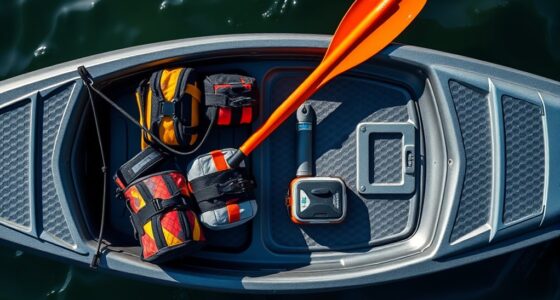To bombproof your Eskimo roll, focus on maintaining your gear—regularly check hatches, paddle integrity, and address leaks immediately. Practice smooth, deliberate paddle strokes engaging your core for better control. Develop consistency through repetition, which builds muscle memory and confidence. Tuning your gear for durability and staying relaxed during recovery help reduce errors. With proper technique and gear harmony, you’ll recover more smoothly. Keep going, and you’ll uncover how to master this essential skill effectively.
Key Takeaways
- Regularly inspect and secure gear to ensure watertight integrity and prevent equipment failure during recovery.
- Practice precise paddle placement and smooth strokes to build muscle memory and reliable technique.
- Maintain and tune gear for optimal performance, reducing disruptions during the roll.
- Focus on steady grip, relaxed hands, and consistent movements to enhance technique and confidence.
- Build confidence through regular practice, gear checks, and mental preparedness for smooth, bombproof recoveries.

Have you ever wondered how some athletes bounce back quickly from setbacks? When it comes to mastering the Eskimo roll, your ability to recover smoothly depends on more than just technique. It hinges on proper gear maintenance and refined paddle techniques that keep you prepared for any situation. Regularly inspecting your kayak and paddle ensures your gear functions flawlessly, minimizing the chances of unexpected malfunctions that could compromise your roll. Check your paddle for cracks or splinters, and ensure your paddle shaft isn’t bent or loose. Your kayak should be watertight, with hatches secured tightly and any leaks addressed promptly. When your gear is well-maintained, you build confidence, knowing that your equipment won’t let you down during critical moments. This attention to detail allows you to focus entirely on executing your paddle techniques with precision, knowing your gear is reliable. Additionally, understanding the Kia Tuning options for your gear can help optimize performance and durability, ensuring your equipment remains resilient in demanding situations. Paddle techniques are fundamental to executing a strong and consistent Eskimo roll. The way you handle your paddle influences your leverage and control when flipping back upright. Practice high-quality paddle placement, keeping your blade close to the kayak’s surface during entry and exit, which provides better stability and power. Your paddle stroke should be smooth and deliberate, avoiding unnecessary jerks that could disrupt your rhythm. Engage core muscles to generate force rather than relying solely on arm strength. As you initiate your roll, your paddle should act as a stabilizer, guiding your body back into an upright position. Keep your hands relaxed on the paddle, maintaining a steady grip that allows fluid movement. Developing muscle memory through repetition helps your paddle techniques become second nature, making your roll more reliable under stress. Consistency in your paddle techniques, combined with diligent gear maintenance, creates a solid foundation for your rolling recovery. When your gear performs flawlessly and your paddle work is precise, you can focus on making small adjustments rather than battling equipment issues or sloppy movements. It’s essential to stay patient and persistent; mastering the Eskimo roll is a process that requires attention to detail. As you refine your paddle techniques and regularly check your gear, you’ll notice your confidence grow, enabling you to recover quickly and smoothly from capsizes. This proactive approach transforms a challenging skill into a dependable part of your kayaking repertoire, allowing you to enjoy the water with peace of mind. Remember, a bombproof Eskimo roll isn’t just about brute force—it’s about harmony between your gear, your technique, and your mindset.
Frequently Asked Questions
How Long Does It Typically Take to Master Rolling Recovery?
Mastering rolling recovery varies depending on your skill progression and the timing duration of practice. Typically, it takes several weeks to a few months of consistent effort to become comfortable with the technique. You might see steady improvements after 10-15 sessions, but full confidence often develops over time. Stay patient, practice regularly, and focus on proper form to speed up your learning process and achieve bombproof results.
What Common Mistakes Hinder Effective Eskimo Roll Recovery?
Imagine trying to open a stubborn jar with a limp wrist—that’s your eskimo roll recovery with incorrect paddle grip. You’re likely to struggle, hindered further by inadequate practice. Common mistakes include gripping the paddle wrong or not drilling the maneuver enough. To improve, focus on correct technique and consistent practice. Don’t let these missteps turn your roll into a comedy of errors; master them, and you’ll roll with confidence.
Can Rolling Recovery Be Performed in Cold or Rough Water Conditions?
In cold water or rough conditions, rolling recovery becomes more challenging but still possible if you stay calm and practice. Cold water can numb your muscles, so make certain you’re wearing appropriate gear like a wetsuit. Focus on smooth, controlled movements, and don’t rush the recovery. Practice in these conditions gradually to build confidence. With proper technique and preparation, you can still perform effective rolling recoveries even in tough, cold, or rough waters.
Is There Specific Gear That Improves Rolling Recovery Success?
You might think any gear works for improving rolling recovery, but specialized paddles and waterproof gear really make a difference. These tools help you stay confident and dry in rough or cold water, increasing your chances of success. Using a lightweight, durable paddle designed for recovery, along with waterproof clothing, guarantees you can focus on your technique without distractions. Gear tailored for your needs boosts your confidence and improves your recovery success rate.
How Do I Stay Calm During a Capsize to Facilitate Recovery?
When you capsize, staying calm is key to a successful recovery. Focus on your breath control by taking slow, deep breaths to keep anxiety at bay. Maintain mental focus on your recovery steps, visualizing the roll and trusting your skills. Keep your body relaxed, and don’t rush. This calm, controlled approach helps you stay centered, making it easier to execute your roll smoothly and confidently.
Conclusion
Now that you know how to bombproof your Eskimo roll, you’re ready to regain confidence after a capsize. Imagine you’re paddling in rough waters, and your boat tips—your practiced roll saves the day. With consistent practice, you’ll react instinctively, turning a stressful situation into a quick recovery. Keep refining your technique, stay patient, and soon your roll will become second nature—making every adventure safer and more enjoyable.










